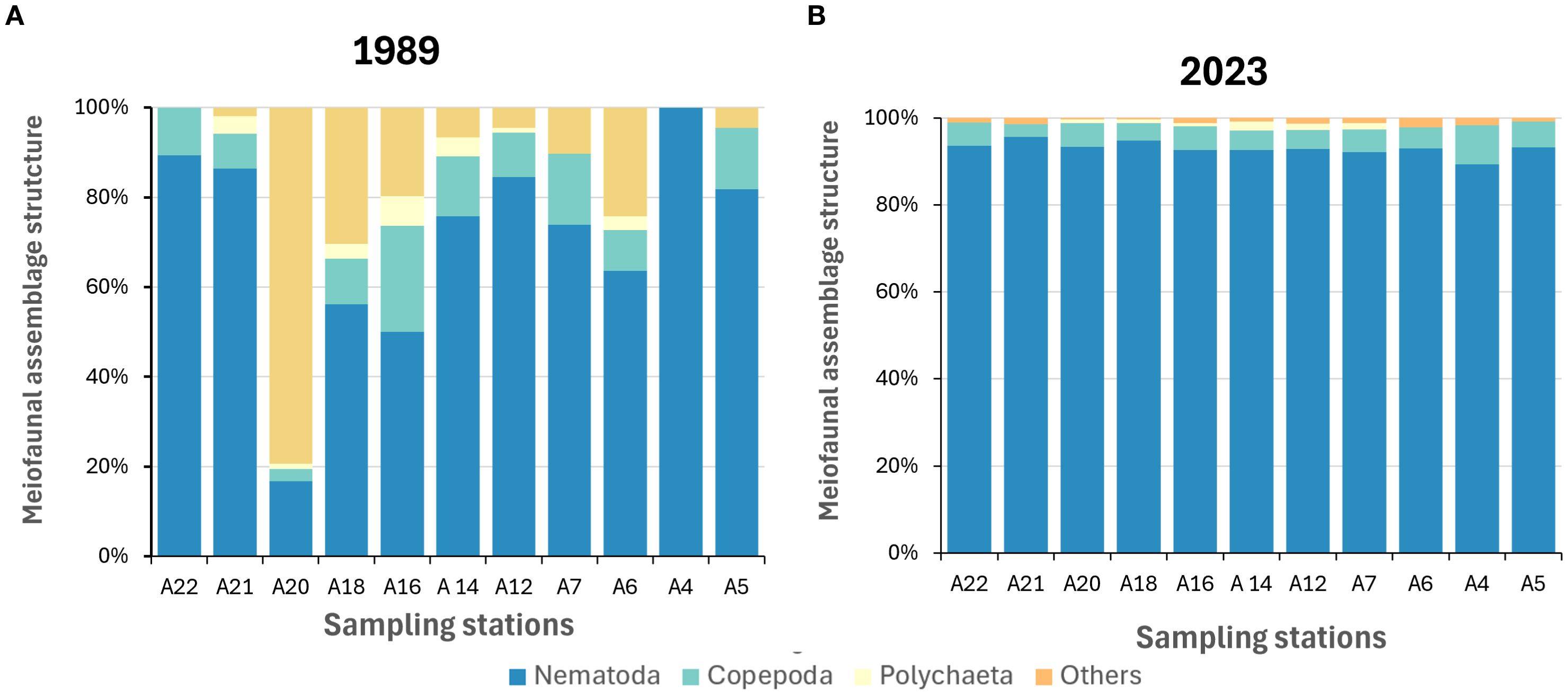- 1Department of Life and Environmental Sciences, Polytechnic University of Marche, Ancona, Italy
- 2Department of Sciences and Engineering of Materials, Environment and Urbanistics, Polytechnic University of Marche, Ancona, Italy
- 3Department of Research Infrastructures for Marine Biological Resources, Stazione Zoologica Anton Dohrn, Fano Marine Centre, Fano, Italy
Major ecosystem changes have been observed in different oceanic regions and have also been reported in the deep sea as a result of complex physical and biological interactions. Here we investigated changes that have occurred in one of the world’s most oligotrophic regions: the deep Eastern Mediterranean Sea. Across a wide area of the Ionian and Aegean Sea, at depths ranging from 500 to 2500 m, we compared historical data dated back to 1989 with new data collected in 2023 exactly at the same sites. Changes in environmental variables (including surface water processes), and sediment organic matter content were related to the benthic response in terms of prokaryotic abundance, and the meiofaunal abundance and composition. We report here that, over this time frame of ca 30 years, this region experienced a progressive increase in bottom water temperatures and of the primary production in the photic zone, which may have determined the accumulation of protein and carbohydrate concentrations in surface sediments. Such changes resulted in an increase of prokaryotic abundance, but contrary to our expectation, were associated with a shift in the meiofaunal community structure and a decrease in the number of higher taxa. This included a reduction in evenness and a major decrease in meiofaunal biomass linked to the major decline of juvenile polychaetes. These results may indicate the altered functioning of the deep-sea ecosystems, with a potential loss of ecosystem services and a simplification of the benthic food webs.
1 Introduction
The deep ocean is experiencing changes in temperature, currents, oxygen concentrations, organic matter input, and cycling (Sweetman et al., 2017). Such changes are the result of the combination of multiple drivers, among which climate change, through its effects on primary production, and episodic events, such as dense shelf-water cascading and circulation perturbations, as in the case of the Eastern Mediterranean Transient (Canals et al., 2006; Roether et al., 1996; Pusceddu et al., 2010), play key roles. The functioning of deep-sea ecosystems is largely driven by food availability, which, in turn, primarily depends on organic carbon export from the photic zone (Corliss et al., 2009; Smith et al., 2009; Danovaro et al., 2017). However, the amount of organic matter reaching the deep seafloor is influenced by different environmental factors, such as production (including its temporal variability), temperature and thermocline, nutrient supply and mixed-layer depth (Brierley and Kingsford, 2009; Doney et al., 2012; Xiu et al., 2018; Lønborg et al., 2020; Yoon et al., 2022).
Long-term monitoring studies have indicated that deep-sea ecosystems are sensitive to climatic variability also through its influence on the quantity and quality of surface primary production (Rogers, 2015), but the dimension of such changes occurring in deep-sea ecosystems and their response to such long-term changes are still largely unknown due to the limited information on alterations happening over decadal timescales.
Recent studies suggest that in the deep-sea there may be an increase in POC fluxes at high latitudes along with changes in seasonality, with dramatic effects on the diversity and abundance of deep-sea communities. For instance, in the Northeast Pacific, changes have included increases in the faunal density but decreases in the diversity (Kuhnz et al., 2014). The changes in temperature, currents, oxygen concentrations and organic matter input are expected to have even a stronger impact in highly oligotrophic regions where deep-sea benthic ecosystems suffer an almost-permanent starvation (Danovaro et al., 2010). Changes in deep-water temperatures can have either direct and indirect effects on biodiversity (Yasuhara and Danovaro, 2016) and even minor temperature shifts, in the order of 0.1-0.4°C, can result in major changes in deep-sea biodiversity and community structure (Danovaro et al., 2004).
The Mediterranean Sea is a miniature ocean (ca 0.8% of the global ocean surface) with a bio-geographic position and a lower average depth (ca 1500 m vs 3750 m of the global ocean), which accelerate the effects of climate change (Parras-Berrocal et al., 2020; Schroeder et al., 2023). In the Western Mediterranean Sea, a warming trend has been observed since the decades 1960-1990, with a temperature increase of approximately 0.12°C at 1600-m depth (Bethoux et al., 1990). Such warming trend in deep waters accelerated over the last 30 years with a rise of bottom temperatures of ca 0.005°C y-1 (Vargas-Yáñez et al., 2017; Kubin et al., 2023). Conversely, during the ‘80s - ‘90s, the Eastern Mediterranean basin showed a drop of deep-water temperatures (around 0.4°C), and an increase in salinity (Roether et al., 1996). This phenomenon, defined “Eastern Mediterranean Transient” (Theocharis et al., 2002), was characterized also by the downwelling of surface waters, which caused a deep-water upwelling up to 100–150 m depth, promoting the primary productivity in the euphotic zone (Psarra et al., 2000). These changes had significant impacts on deep-sea biodiversity, and ecosystem functions in the ‘90s (Danovaro et al., 2001, 2004), including a significant decline in the meiofaunal functional diversity and evenness, coupled with changes in the community composition. These effects were particularly evident in nematodes and are thought to be linked to temperature changes. These examples make evident the highly dynamic response of deep-sea ecosystems to changes in the hydrodynamic and productivity features (Danovaro et al., 2001).
To investigate the changes occurred on deep-sea ecosystems of the Mediterranean Sea from the ‘90s to the present (2023) we compared the results of a study carried out in 1989 (Danovaro et al., 1993, 1995) over a wide deep-sea region of the Eastern mediterranean, by collecting samples in the same sites, using the same methodologies, to ensure a reliable comparison.
The aim of the present study is to gain insights into the biological response and to understand the sensitivity to environmental changes of a deep-sea ecosystem in the extremely oligotrophic Eastern Mediterranean Sea.
2 Materials and methods
2.1 Study area
The present study was carried out in the Eastern Mediterranean Sea (Figure 1), one of the most oligotrophic areas of the Mediterranean Sea (Tselepides and Eleftheriou, 1992). In April 2023 sediment samples were collected onboard of the R/V Aegaeo in 11 stations at depths ranging from 500 to 2500 m (Supplementary Table 1) (Figure 1). The station location, sampling tools, procedures, protocols, and sample preservation and storage were the same as those used in September 1989. To ensure consistency with the sampling carried out in 1989, samples were collected using a USNEL-type box corer, ensuring the collection of undisturbed surface sediments with clear water on top of the sediment surface. For each station three replicates were collected. From each replicate deployment, one liner (corer) was used for meiofauna and one for the biochemical analyses thus ensuring the collection of independent replicates. For each replicate core used for biochemical analyses, a sediment sample was collected using a sterile spatula for prokaryotic analyses. Each core was sectioned in layers (0-1cm, 1-3cm, 3-5cm, 5-10cm, 10–15 cm) for a total of 330 samples preserved at -20°C until laboratory analyses.
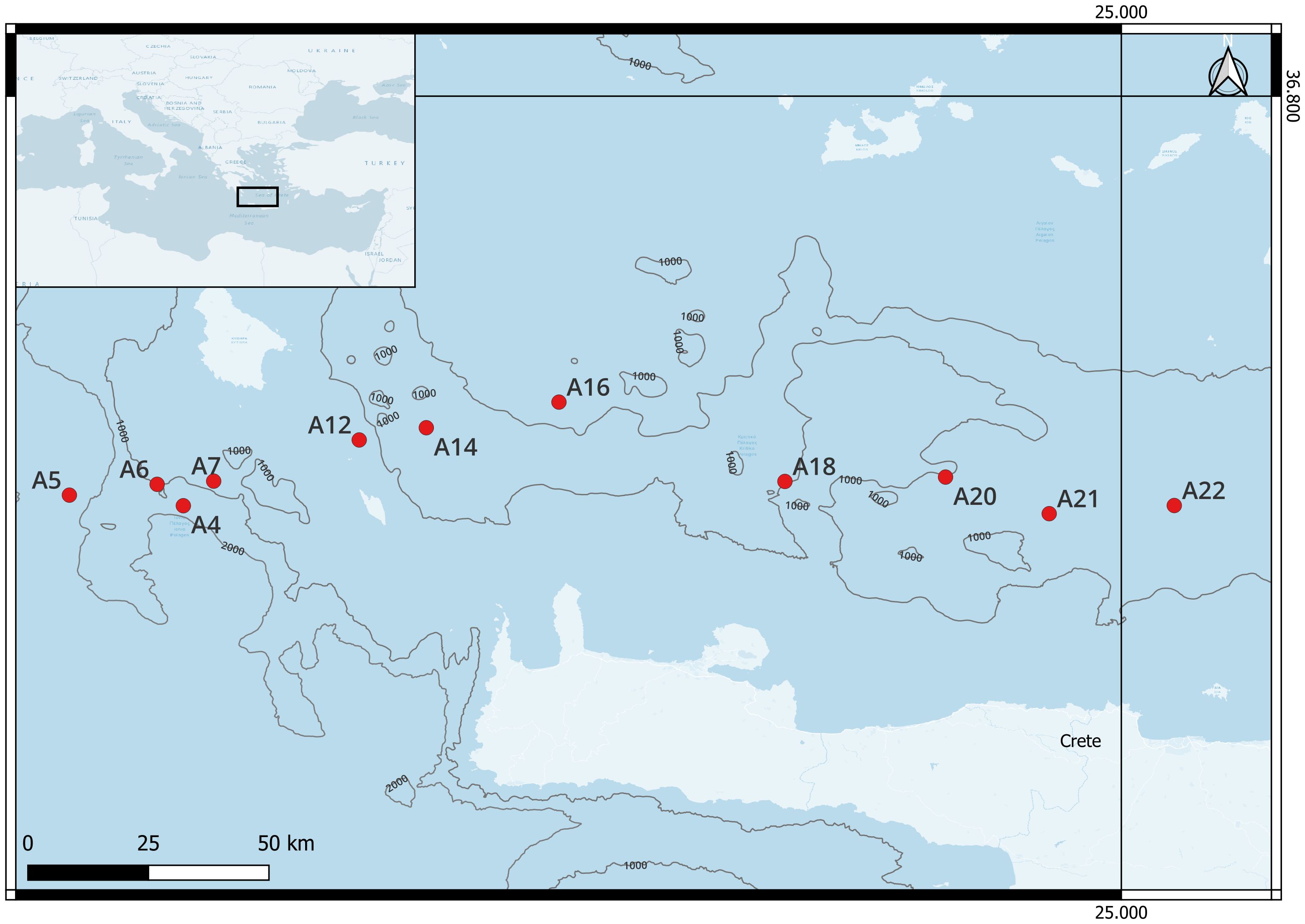
Figure 1. Map showing the sampling stations located off the northern coast of Crete, in the Eastern Mediterranean Sea.
2.2 Environmental variables
Monthly mean data on sub-surface (97-m depth) chlorophyll-a concentrations and potential bottom water temperature were obtained from datasets provided by EU Copernicus Marine Services (Escudier et al., 2020; European Union-Copernicus Marine Service, 2018, 2019, 2020; Feudale et al., 2023), by selecting the area of study (coordinates 36.132 N, 34.945 S,22.893 W, 26.452 E). Chlorophyll-a data are available at a horizontal resolution of 0.25°, while the temperature data are at a resolution of 1/16° with 72 vertical levels. For both datasets, we used monthly means as provided, without applying further temporal or spatial aggregation. These datasets were selected for gathering information on temperature and primary productivity changes across the period 1989-2023.
2.3 Biochemical composition of organic matter
Protein, carbohydrate, and lipid contents of sediment samples were determined following the protocols described by Danovaro (2009), using a Shimadzu spectrophotometer (Model UV-1700). Proteins were extracted in a hot water bath and quantified using the Lowry method, with Reagent A (0.5 N NaOH), Reagent B (Folin–Ciocalteu reagent), and Reagent C (copper sulphate solution) (Supplementary Table 2), measuring absorbance at 650 nm. Carbohydrates were measured using the phenol–sulphuric acid method (absorbance at 485 and 600 nm) after drying and rehydration of the sediment. Lipids were extracted with a chloroform–methanol mixture, carbonized with sulfuric acid, and quantified at 375 nm. All samples were centrifuged at 800 × g between steps.
As determined in 1989, we also quantified the concentration of Labile organic matter (LOM) as the sum of all carbohydrate, protein and lipid concentrations, expressed in mg/g. The concentrations of carbohydrates, proteins and lipids were transformed into carbon equivalents to determine the concentration of Biopolymeric C (BPC), using the coefficients 0.40, 0.49 and 0.75 µg C µg-1 respectively (Fabiano et al., 1995).
2.4 Prokaryotic abundance
Prokaryotic abundance was analyzed following Danovaro (2009): surface sediment samples were collected manually with a sterile spatula and preserved in formaldehyde (2%). Samples were sonicated and subsamples were diluted 200 times. The subsamples were filtered on 0.22 Black Nucleopore filters and stained with SYBR Green I, afterwards they were incubated for 20 minutes and filtered again with pre-filtered seawater. Once ready, the filters were placed on a glass slide and examined under an epifluorescence microscope (Zeiss Universal microscope). Ten to twenty grids were randomly chosen and at least 200 cells were counted.
2.5 Meiofauna
Meiofauna extraction followed the protocol by Danovaro (2009). Samples were sonicated three times for one minute and sieved through a 500 and a 40 µm meshes, retaining the organisms within these size range, which were considered as the meiofaunal fraction (Danovaro, 2009). Remaining sediment was mixed with Ludox TM and centrifuged three times at 3000 rpm (800 x g). After each centrifugation, the supernatant was sieved again, and the collected material was fixed in 70% ethanol with Bengal Rose dye for staining. Identification and counting of meiofauna to the order level was performed using a Leica stereomicroscope (3.5X) on a cuvette box with a grid of 200 cells. Individuals of each taxon were enumerated to determine the abundance (expressed as individuals per 10 cm2). The meiofaunal biomass was calculated by using the volumetric method, which consists in extrapolating organism dry weight from their biovolume. This can be obtained from body length (L) and width (W) of each individual, and specifically for nematodes using the equation proposed by Warwick and Price (1979). Meiofaunal specimens were first mounted on slides after formalin–ethanol–glycerol treatment to prevent dehydration (Danovaro, 2009), then measured following the same process as above but under an optical microscope (40x) and following the formula proposed by Andrassy (1956).
2.6 Statistical analyses
To test for differences in the biochemical composition of organic matter, meiofaunal abundance, biomass and composition, and prokaryotic abundance among stations and between 1989 and 2023, permutational analyses of variance (PERMANOVA) were performed. Additionally, to identify the potential drivers (primary productivity expressed as the concentration of chlorophyll-a, potential bottom temperature, organic matter components) of meiofaunal composition a Redundancy Analysis (RDA) was carried out (Supplementary Figure 1), based on Bray-Curtis similarity index calculated from meiofaunal abundance data (individuals per 10 cm2), after square-root transformation. All analyses were performed using PRIMER-e v.7 computer programme.
3 Results
3.1 Environmental parameters
Data from 1989 to 2023, showed an increasing trend in potential bottom temperatures in the entire investigated region. The results point out an overall average increase of ca 0.3°C over the past 30 years (from 14.16°C in 1989 to 14.49°C in 2023), as confirmed by linear regression analysis (p<0.001) (Figures 2A, B). This warming trend cannot be explained by seasonal variability, as seasonal temperature changes within each year were limited to about 0.1°C in both 1989 and 2023.
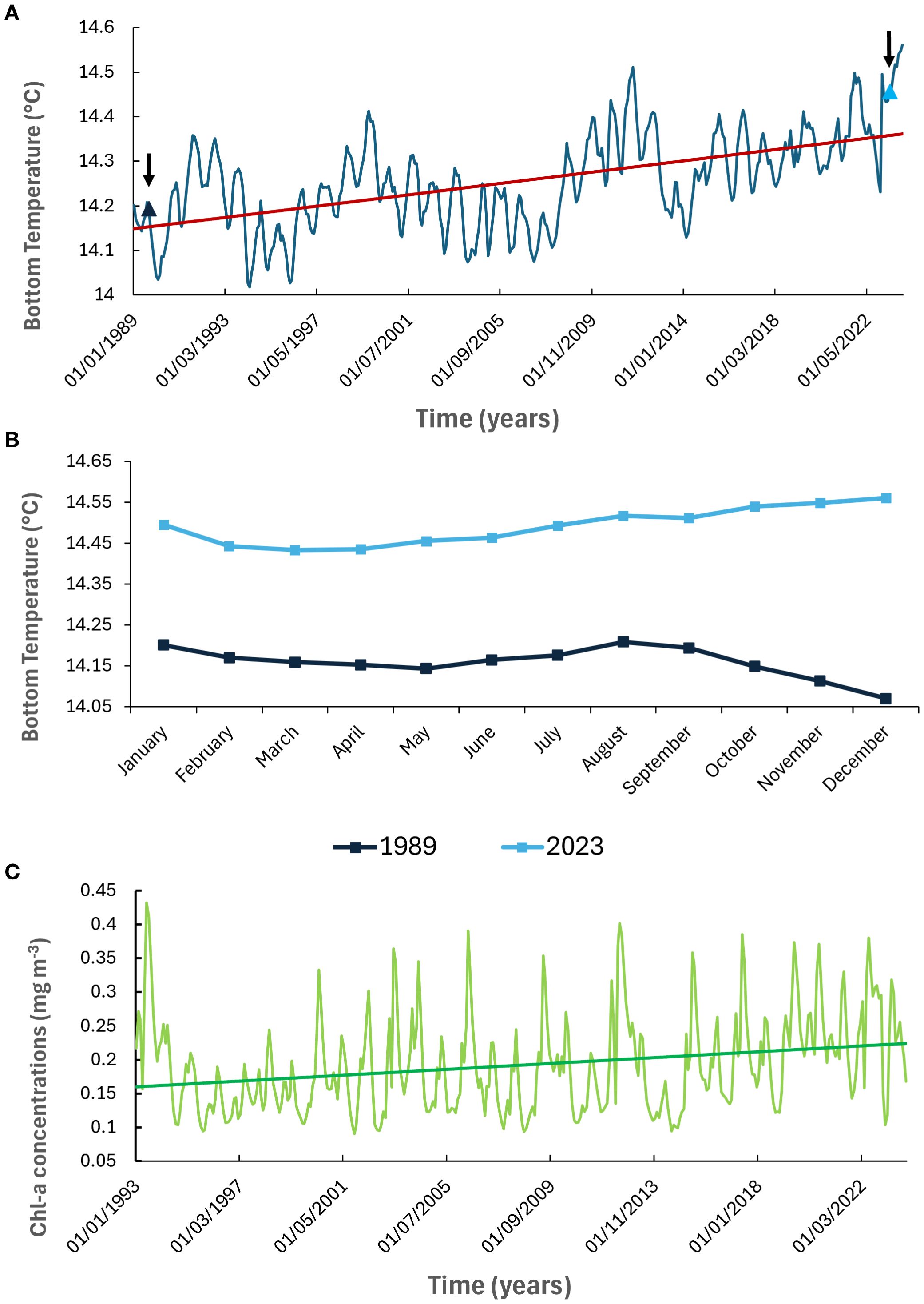
Figure 2. Temporal pattern in potential bottom water temperatures from 01/01/1989 to 01/12/2023 in the Southern Aegean Sea (coordinates 36.132 N, 34.945 S,22.893 W, 26.452 E), the dark blue triangle represents the temperature at the sampling time (September) in 1989, the light blue triangle represents the temperature at the sampling time (April) in 2023 (A). Average monthly temperatures in 1989 and in 2023 (B). Temporal patterns of sub-surface chlorophyll-a concentrations from 1993 to 2023 (C).
We also explored the temporal patterns for sub-surface chlorophyll-a concentrations (data available only from 1993 to 2023). Although the data show a significant seasonal variability, we identified a tendency of chlorophyll-a concentration to increase over the past three decades (p<0.001; Figure 2C).
3.2 Biochemical composition of organic matter
Overall, the organic matter in the sediments has increased when comparing the year 1989 with 2023. In particular, the labile organic matter (LOM) and biopolymeric carbon (BPC) concentrations increased by 21% and 28% respectively (Figure 3A). Since they depend on the variables considered, it was observed that proteins increased significantly from 0.28 mg g-1 ± 0.02 in 1989 to 0.67 ± 0.04 mg g-1 in 2023 (PERMANOVA p<0.001), carbohydrates slightly increased from 1.71 ± 0.05 to 2.15 ± 0.14 mg g-1, while lipids showed a decrease from 0.33 ± 0.02 to 0.30 ± 0.04 mg g-1 (Figure 3B; Supplementary Table 2). In terms of organic matter composition, carbohydrates remained the dominant component although in lower percentage (63 vs. 60% in 1989 and 2023 respectively), while the contribution of proteins increased (12% in 1989 and 23% in 2023), and lipids decreased (24% in 1989 and 16% in 2023).
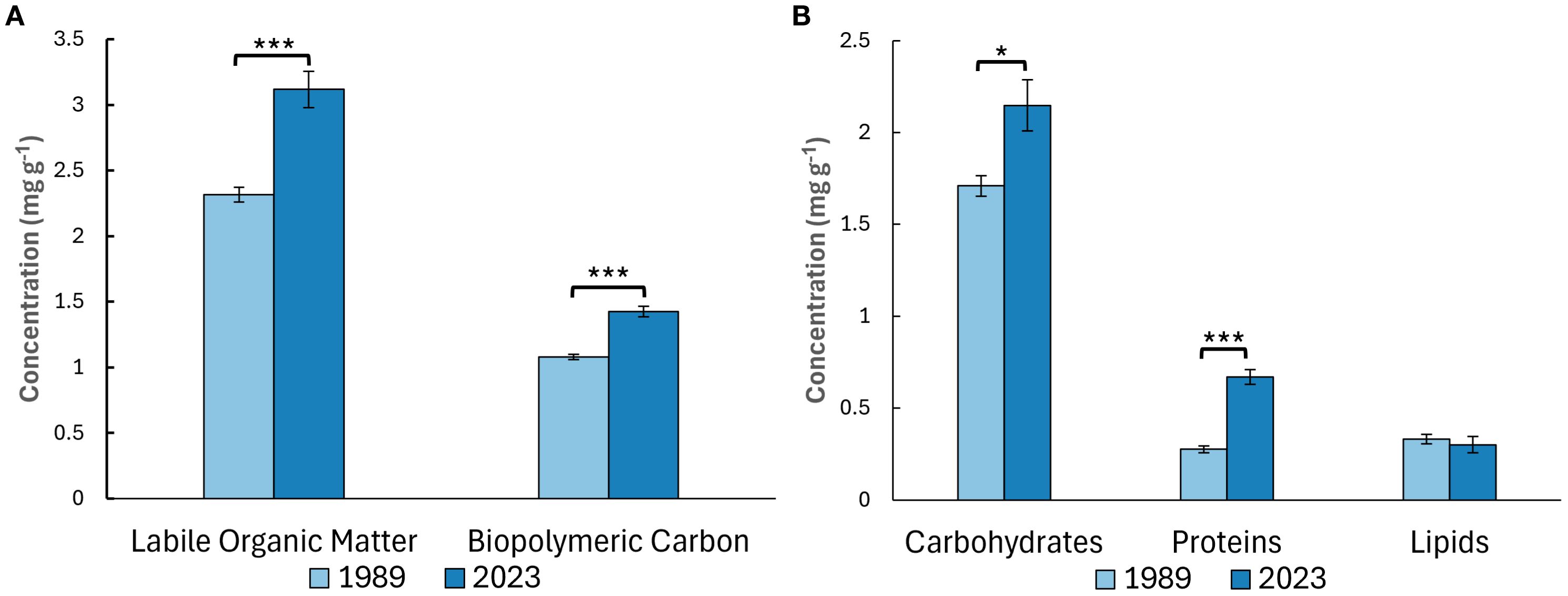
Figure 3. Carbohydrate, protein, lipid, biopolymeric carbon and labile organic matter contents in the sediments of the studied area in 1989 and 2023. The plots show the biopolymeric carbon (BPC) and labile organic matter (LOM) (A) and the carbohydrates, proteins, and lipid (B) contents in the two sampling years (1989 vs 2023) within the area of study. Error bars represent standard errors. Significant differences are reported as: *p < 0.05, ***p < 0.001.
3.3 Prokaryotic abundance
Prokaryotic abundance overall increased significantly from 1989 (0.72 x 108 cells g-1) to 2023 (1.55 x 108 cells g-1) (Figure 4). In 1989, prokaryotic abundance ranged from 0.16 to 1.91 x 108 cells g-1. In 2023, prokaryotic abundance ranged from 1.26 to 2.00 x 108 cells g-1 (at station A16 and A5, respectively).
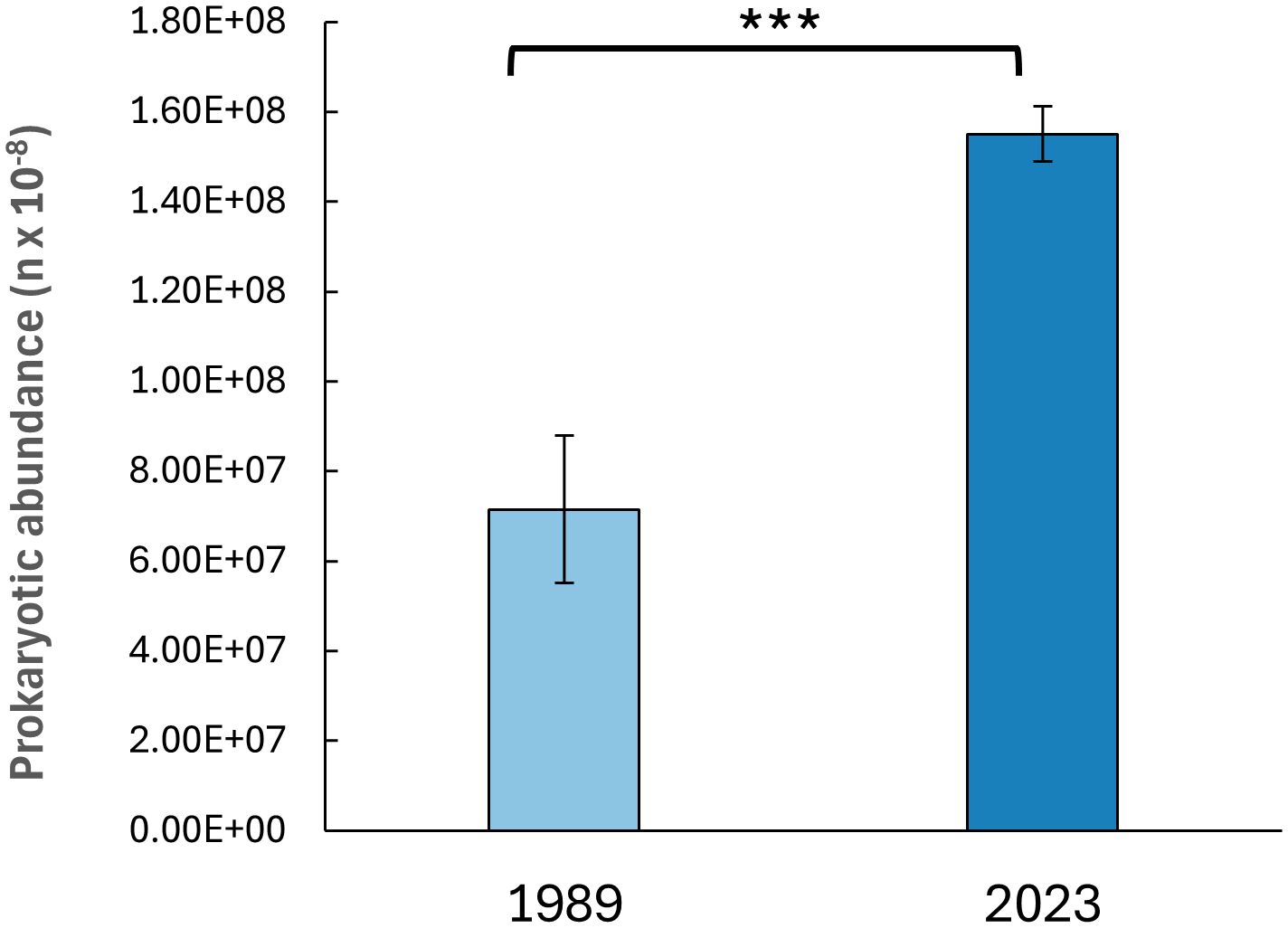
Figure 4. Prokaryotic abundances in 1989 and in 2023. Error bars represent standard errors. Significant differences are reported as: ***p < 0.001.
3.4 Meiofaunal assemblage composition
In 1989, overall, 11 meiofaunal higher taxa, from the level of order to phylum were observed: nematodes, polychaetes, harpacticoid copepods, turbellarians, oligochaetes, tardigrades, ostracods, tanaidaceans, kinorhynchs, molluscs and halacaridae. In 2023, the total number of higher taxa was 10, which not only reduced but also changed, with the lack of oligochaetes, ostracods and molluscs that were present in 1989 and the presence of cumaceans and priapulids larvae that were instead missing in 1989. In addition, we observed a clear shift in the assemblage structure, with a reduction of rare taxa, defined here as those that were either absent or contributing <1% to the total abundance (Pusceddu et al., 2011), (represented as “others”), and a marked increase in the dominance of nematodes (Figure 5).
3.5 Meiofaunal abundance and biomass
The average abundance of meiofauna did not change significantly between 1989 and 2023 (Figure 6A). In 1989, at Station A20 an unusual peak in turbellarian abundance (196 ind. 10 cm-2) was observed. Such value was not confirmed in 2023. Other stations showed some differences in terms of total abundance (mostly due to nematodes) or rare taxa. Nematodes were always the most abundant taxon but increased their numerical dominance from 1989 (68% of total meiofaunal abundance) to 2023 (93%).
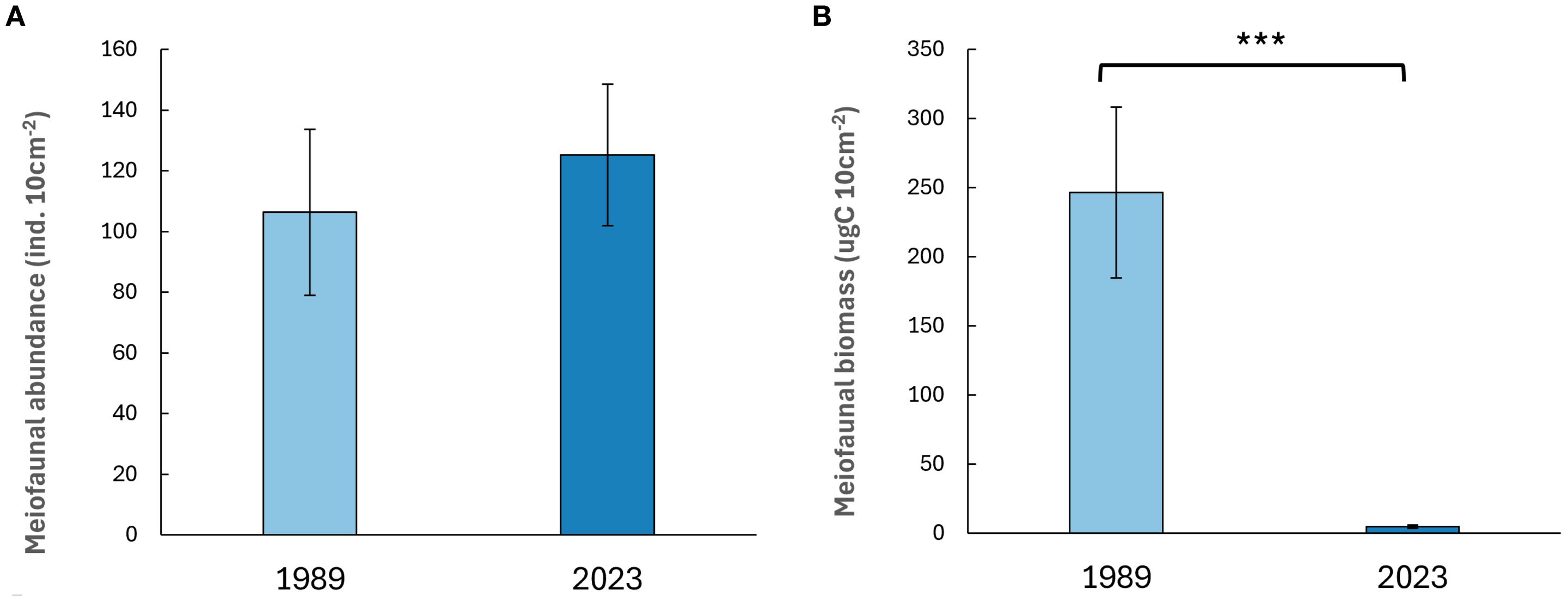
Figure 6. Meiofaunal abundance (A) and biomass (B) in 1989 and in 2023. Error bars represent standard errors. Significant differences are reported as: ***p < 0.001.
In terms of biomass, a significant decrease from 1989 to 2023 was observed (Figure 6B). The highest biomass value was observed in 1989 at station A20 (585.1 µg C/10 cm2), compared to the highest value of 13.7 µg C/10 cm2 at station A12 in 2023. Station A4 was the only one that did not experience a notable change in biomass values (2.8 µg C/10 cm2 in 1989 and 2.90 µg C/10 cm2 in 2023) (Supplementary Table 3). The average among stations in 1989 was 246.5 µg C/10 cm2, which decreased to 4.7 µg C/10 cm2 in 2023. The results from the PERMANOVA test confirmed statistically these results with p < 0.001. This drastic shift can be attributed to changes in the taxonomic composition. In 1989, polychaetes were the dominant taxon contributing to biomass values (ca 72%), followed by nematodes (14%) and copepods (12%). However, in 2023, nematodes were the primary contributors to biomass (57%), followed by copepods (27%) and polychaetes (13%) (Supplementary Figure 2).
4 Discussion
The Mediterranean basin is characterized by a clear gradient of decreasing productivity moving eastwards (Danovaro et al., 2010), which is due to the limited continental (river) inputs in the Eastern basin and the increasing distance from the nutrient rich and productive Atlantic waters. The ultra-oligotrophic Cretan Sea in the Eastern Mediterranean has become a paradigmatic example to comprehend the biotic response to such extreme trophic conditions and the Mediterranean gradient is a model to investigate the response of deep-sea ecosystems to a progressive food limitation due to climate change (Danovaro et al., 2001, -2008).
During the last 30 years several changes have occurred in the Mediterranea Sea at regional level. From 1990 to 1995, the so-called “Eastern Mediterranean transient” determined an increase in primary production (Psarra et al., 2000). After 1995, the eastern Mediterranean water masses returned to the pre-transient conditions, but according to the chlorophyll-a data reported here (Copernicus data base) the increasing trend of primary productivity continued also in the following decades, until a few years ago, also as a result of a novel upwelling of nutrient-rich deep waters observed in 2017-2019 (Potiris et al., 2024).
The comparison between two sampling periods (1989 vs 2023, i.e., ca 30 years apart and without taking into account the presence of a seasonal variability), cannot reflect the full succession of ecological and environmental changes that occurred in the deep sea, the results from two snapshots were useful to understand how deep-sea ecosystem changed during this time frame. In addition, the analysis covered a wide area (extending for ca. 5000 km) and across a considerable bathymetric range (500–2500 m depth) and was based on the use of the same sampling devices, methodologies (including sieves size, cores’ length) and protocols used for the analyses carried out in 1989, ensuring a robust and consistent comparison.
Generally, an increase in the ocean productivity, as the one observed in the Eastern Mediterranean from 1993 onward, is associated with an increase in the export of organic matter to the deep seafloor (Tamelander et al., 2013). The results reported here for a wide sector of the Eastern Mediterranean confirmed that the increase of primary production observed from satellite data resulted in a significant increase of the concentrations of labile organic matter on surface deep-sea sediments, particularly in terms of proteins and carbohydrates, which led to an overall increase in the food availability to the deep-sea biota.
These results confirm the tight link between processes occurring in the water column and the benthic response, and were reflected by a ca 20% increase in concentrations of the bulk of labile organic matter in 2023 when compared to 1989. The linkage between primary productivity (increase in sub-surface chlorophyll-a concentrations, used as a proxy of primary productivity) and sedimentary organic matter composition was evident for the two biochemical classes of organic matter (proteins and carbohydrates) that dominate the biochemical composition of phytoplankton.
Changes in food availability, especially in ultra-oligotrophic deep-sea sediments, typically determine a significant benthic response (Danovaro et al., 2000; Nomaki et al., 2021). Prokaryotes displayed the most significant response to the increase in food supply, doubling their abundance in 2023 when compared to 1989. This result is somewhat expected as it is known that the microbial components can react promptly to changes in environmental conditions and food availability (Danovaro et al., 2000). Conversely, the results for the multicellular components (metazoan meiofauna) were far more complex than expected, as meiofaunal abundance did not change significantly from 1989 to 2023, but nematodes increased notably their contribution to the total meiofaunal abundance. This result was associated with a shift in the meiofaunal community structure and, even more importantly, with a decrease of the relative abundance of meiofaunal taxa. In particular, in 2023, we reported the lack of oligochaetes, molluscs and ostracods that were present in 1989 and the appearance of cumaceans and priapulids larvae that were missing in 1989. We cannot exclude that some of these taxa might be subjected to seasonal or recruitment-related changes over time, yet the observed turnover in higher taxa and their complete absence in the whole deep-sea region, leads to hypothesise that the observed changes are significant and evident at high taxonomic levels (i.e., class level).
Such changes were substantiated by a significant drop in meiofaunal biomass from 1989 to 2023. In particular, polychaetes decreased in both abundance and contribution to total biomass by approximately 60% or more. This was accompanied by a dramatic decline in turbellarians, with losses exceeding 90%. While differences in sampling months may account for the presence of larval forms, the substantial decline in both temporary and permanent meiofaunal taxa (i.e., polychaetes and turbellarians, respectively) indicates the presence of significant ecological changes that extend beyond seasonal variability.
These changes were corroborated by macrofaunal analyses conducted at the same stations and sampling times, which showed a marked decrease in abundance (from >100 to 16.8 individuals m-2), as well as in their contribution to the macrofaunal assemblage—from 60–72% in 1989 to 5–10% in 2023 (Marcucci, 2024).
The shift toward smaller and more opportunistic taxa may be a consequence of these changes, potentially leading to a substantial alteration in ecological functions, as the most affected taxa, polychaetes and turbellarians, represent a significant fraction of deep-sea predators. These predatory taxa were largely replaced by deposit feeders and bacterivorous taxa (dominant among deep-sea nematodes), which reflect an increase in organic detritus and in the abundance of benthic prokaryotes.
The overwhelming dominance of nematodes in 2023 coupled with the disappearance of some higher taxa and the drop in the overall meiofaunal biomass over ca 30 years, suggest that major environmental changes and ecological changes occurred, and that these changes had a clear impact on deep-sea biota leading to an overall simplification of the benthic food webs.
The comparison between the two sampling periods also indicates that, despite the increase in primary productivity, the deep-sea ecosystems of the Eastern Mediterranean showed the increase of the dominance of the microbial biomass and the decrease in animal biomass, a process that could be defined as “miniaturization” of the key biological components accounting for the whole biomass. Such changes were coupled with a lower ability to channel the larger inputs of primary organic matter, observed in 2023, into biomass, which indicate the global impoverishment of the deep-sea ecosystem functions and thus a lower capacity to support the transfer of energy (biomass) to higher trophic levels.
Our results provide new insights into the functioning of the extremely oligotrophic deep-sea ecosystems, such as the Eastern Mediterranean Sea, and suggest that food availability alone is not sufficient to predict the complex multitrophic interactions occurring in the deep sea. In addition, the results obtained comparing the same deep-sea region from 1989 and 2023 indicate a drop in ecosystem services (here expressed in terms of biomass) and a simplification of the benthic food webs.
The results of the present study from the deep-Mediterranean Sea and the presence of ecosystem shifts in other marine ecosystems worldwide, suggest the need of a more systematic and long-term time-series monitoring and as well as the collection of ecological data to better assess the ecological implications of such changes over the largest ecosystems of the biosphere.
Data availability statement
The raw data supporting the conclusions of this article will be made available by the authors, without undue reservation.
Author contributions
AK: Writing – original draft, Data curation, Investigation, Visualization, Writing – review & editing, Formal Analysis. CG: Validation, Methodology, Data curation, Writing – review & editing. ML: Methodology, Data curation, Validation, Writing – review & editing. CC: Visualization, Funding acquisition, Conceptualization, Writing – review & editing. AD: Writing – review & editing, Funding acquisition, Resources, Visualization. MT: Resources, Validation, Funding acquisition, Writing – review & editing. RD: Supervision, Funding acquisition, Conceptualization, Writing – original draft, Resources, Project administration.
Funding
The author(s) declare that financial support was received for the research and/or publication of this article. This work was supported by PRIN -Progetti di Ricerca di Rilevante Interesse Nazionale, under grant 2017-FREXZY, within the framework of the Project GLIDE. Additional support was provided by the European Union through the HORIZON Innovation Action project REDRESS -Restoration of deep-sea habitats to rebuild European Seas (Project number: 101135492), funded under the call HORIZON-CL6-2023-BIODIV-01. This research also received funding from the Italian National Recovery and Resilience Plan (PNRR), Mission 4 Component 2 Investment 1.4-Call for tender no. 3138 of 16 December 2021, rectified by Decree no. 3175 of 18 December 2021 by the Italian Ministry of University and Research, funded by the European Union-NextGenerationEU, Award Number: project code CN_00000033, Concession Decree No. 1034, of 17 June 2022, adopted by the Italian Ministry of University and Research, Project title “National Biodiversity Future Center -NBFC”.
Acknowledgments
We want to thank the Hellenic Centre for Marine Research (HCMR) for providing access to the R/V Aegaeo, and the captain and crew of the R/V Aegaeo for their valuable assistance during the field work. We would also like to acknowledge Francesca Marcellini and the Marine Biology Students at the Polytechnic University of Marche for their essential support during sampling onboard of the R/V Aegaio.
Conflict of interest
The authors declare that the research was conducted in the absence of any commercial or financial relationships that could be construed as a potential conflict of interest.
Generative AI statement
The author(s) declare that no Generative AI was used in the creation of this manuscript.
Publisher’s note
All claims expressed in this article are solely those of the authors and do not necessarily represent those of their affiliated organizations, or those of the publisher, the editors and the reviewers. Any product that may be evaluated in this article, or claim that may be made by its manufacturer, is not guaranteed or endorsed by the publisher.
Supplementary material
The Supplementary Material for this article can be found online at: https://www.frontiersin.org/articles/10.3389/fmars.2025.1612914/full#supplementary-material
References
Andrassy I. (1956). Die Rauminhalts- und Gewichtsbestimmung der Fadenwurmer (Nematoden). Acta zoologica 2, 1–15.
Bethoux J. P., Gentili B., Raunet J., and Tailliez D. (1990). Warming trend in the western Mediterranean deep water. Nature 347, 660–662. doi: 10.1038/347660a0
Brierley A. S. and Kingsford M. J. (2009). Impacts of climate change on marine organisms and ecosystems. Curr. Biol. 19, R602–R614. doi: 10.1016/j.cub.2009.05.046
Canals M., Puig P., and de Madron X. (2006). Flushing submarine canyons. Nature 444, 354–357. doi: 10.1038/nature05271
Corliss B. H., Brown C. W., Sun X., and Showers W. J. (2009). Deep-sea benthic diversity linked to seasonality of pelagic productivity. Deep Sea Res. Part I: Oceanographic Res. Papers 56, 835–841. doi: 10.1016/j.dsr.2008.12.009
Danovaro R. (Ed.) (2009). Methods for the Study of Deep-Sea Sediments, Their Functioning and Biodiversity. 1st ed (Boca Raton: CRC Press). doi: 10.1201/9781439811382
Danovaro R., Company J. B., Corinaldesi C., D’Onghia G., Galil B., Gambi C., et al. (2010). Deep-sea biodiversity in the Mediterranean sea: the known, the unknown, and the unknowable. PloS One 5, e11832. doi: 10.1371/journal.pone.0011832
Danovaro R., Corinaldesi C., Dell’Anno A., and Snelgrove P. V. R. (2017). The deep-sea under global change. Curr. Biol. 27, R461–R465. doi: 10.1016/j.cub.2017.02.046
Danovaro R., Croce N. D., Eleftheriou A., Fabiano M., Papadopoulou N., Smith C., et al. (1995). Meiofauna of the deep Eastern Mediterranean Sea: Distribution and abundance in relation to bacterial biomass, organic matter composition and other environmental factors. Prog. Oceanography 36, 329–341. doi: 10.1016/0079-6611(96)00002-X
Danovaro R., Dell’Anno A., Fabiano M., Pusceddu A., and Tselepides A. (2001). Deep-sea ecosystem response to climate changes: The eastern Mediterranean case study. Trends Ecol. Evol. 16, 505–510. doi: 10.1016/S0169-5347(01)02215-7
Danovaro R., Dell’Anno A., and Pusceddu A. (2004). Biodiversity response to climate change in a warm deep sea. Ecol. Lett. 7, 821–828. doi: 10.1111/j.1461-0248.2004.00634.x
Danovaro R., Fabiano M., and Della Croce N. (1993). Labile organic matter and microbial biomasses in deep-sea sediments (Eastern Mediterranean Sea). Deep Sea Res. Part I: Oceanographic Res. Papers 40, 953–965. doi: 10.1016/0967-0637(93)90083-F
Danovaro R., Gambi C., Dell’Anno A., Corinaldesi C., Fraschetti S., Vanreusel A., et al. (2008). Exponential decline of deep-sea ecosystem functioning linked to benthic biodiversity loss. Curr. Biol. 18, 1–8. doi: 10.1016/j.cub.2007.11.056
Danovaro R., Marrale D., Dell’Anno A., Croce N. D., Tselepides A., and Fabiano M. (2000). Bacterial response to seasonal changes in labile organic matter composition on the continental shelf and bathyal sediments of the Cretan Sea. Prog. Oceanography 46, 345–366. doi: 10.1016/S0079-6611(00)00025-2
Doney S. C., Ruckelshaus M., Emmett Duffy J., Barry J. P., Chan F., English C. A., et al. (2012). Climate change impacts on marine ecosystems. Annu. Rev. Mar. Sci. 4, 11–37. doi: 10.1146/annurev-marine-041911-111611
Escudier R., Clementi E., Omar M., Cipollone A., Pistoia J., Aydogdu A., et al. (2020). Mediterranean Sea Physical Reanalysis (CMEMS MED-Currents, E3R1 system): MEDSEA_MULTIYEAR_PHY_006_004 (Versione 1) (Brussels, Belgium: Copernicus Monitoring Environment Marine Service (CMEMS). doi: 10.25423/CMCC/MEDSEA_MULTIYEAR_PHY_006_004_E3R1
European Union-Copernicus Marine Service (2018). Global ocean biogeochemistry hindcast (Brussels, Belgium: Copernicus Marine Environment Monitoring Service (CMEMS)). doi: 10.48670/MOI-00019
European Union-Copernicus Marine Service (2019). Global Ocean Biogeochemistry Analysis and Forecast (Brussels, Belgium: Copernicus Marine Environment Monitoring Service (CMEMS)). doi: 10.48670/MOI-00015
European Union-Copernicus Marine Service (2020). Global Ocean 3D Chlorophyll-a concentration, Particulate Backscattering coefficient and Particulate Organic Carbon (Brussels, Belgium: Copernicus Marine Environment Monitoring Service (CMEMS)). doi: 10.48670/MOI-00046
Fabiano M., Danovaro R., and Fraschetti S. (1995). A three-year time series of elemental and biochemical composition of organic matter in subtidal sandy sediments of the Ligurian Sea (northwestern Mediterranean). Continental Shelf Res. 15, 1453–1469. doi: 10.1016/0278-4343(94)00088-5
Feudale L., Bolzon G., Lazzari P., Salon S., Teruzzi A., Di Biagio V., et al. (2023). Mediterranean Sea Biogeochemical Analysis and Forecast (Copernicus Marine Service MED-Biogeochemistry, MedBFM4 system): MEDSEA_ANALYSIS_FORECAST_BGC_006_014_MedBFM4 (Versione 2) (Copernicus Marine Service). doi: 10.25423/CMCC/MEDSEA_ANALYSISFORECAST_BGC_006_014_MEDBFM4
Kubin E., Menna M., Mauri E., Notarstefano G., Mieruch S., and Poulain P.-M. (2023). Heat content and temperature trends in the Mediterranean Sea as derived from Argo float data. Front. Mar. Sci. 10. doi: 10.3389/fmars.2023.1271638
Kuhnz L. A., Ruhl H. A., Huffard C. L., and Smith K. L. (2014). Rapid changes and long-term cycles in the benthic megafaunal community observed over 24years in the abyssal northeast Pacific. Prog. Oceanography 124, 1–11. doi: 10.1016/j.pocean.2014.04.007
Lønborg C., Carreira C., Jickells T., and Álvarez-Salgado X. A. (2020). Impacts of global change on ocean dissolved organic carbon (DOC) cycling. Front. Mar. Sci. 7. doi: 10.3389/fmars.2020.00466
Marcucci F. (2024). Long-term changes in macrofauna assemblages and deep-sea ecosystems of the Aegean Sea (Ancona, Italy: MSc Thesis - Polytechnic University of Marche), 64 pp.
Nomaki H., Rastelli E., Alves A., Suga H., Ramos S., Kitahashi T., et al. (2021). Abyssal fauna, benthic microbes, and organic matter quality across a range of trophic conditions in the western Pacific ocean. Prog. Oceanography 195, 102591. doi: 10.1016/j.pocean.2021.102591
Parras-Berrocal I. M., Vazquez R., Cabos W., Sein D., Mañanes R., Perez-Sanz J., et al. (2020). The climate change signal in the Mediterranean Sea in a regionally coupled atmosphere–ocean model. Ocean Sci. 16, 743–765. doi: 10.5194/os-16-743-2020
Potiris M., Mamoutos I. G., Tragou E., Zervakis V., Kassis D., and Ballas D. (2024). Dense water formation in the North–Central Aegean sea during winter 2021–2022. J. Mar. Sci. Eng. 12, 2. doi: 10.3390/jmse12020221
Psarra S., Tselepides A., and Ignatiades L. (2000). Primary productivity in the oligotrophic Cretan Sea (NE Mediterranean): Seasonal and interannual variability. Prog. Oceanography 46, 187–204. doi: 10.1016/S0079-6611(00)00018-5
Pusceddu A., Bianchelli S., Gambi C., and Danovaro R. (2011). Assessment of benthic trophic status of marine coastal ecosystems: Significance of meiofaunal rare taxa. Estuarine Coast. Shelf Sci. 93, 420–430. doi: 10.1016/j.ecss.2011.05.012
Pusceddu A., Mea M., Gambi M., Bianchelli S., Canals M., Sanchez-Vidal A., et al (2010). Ecosystem effects of dense water formation on deep Mediterranean Seaecosystems: an overview. Adv. Oceanogr. Limnol. 6 (1), 67–83. doi: 10.1080/19475721003735765
Roether W., Manca B. B., Klein B., Bregant D., Georgopoulos D., Beitzel V., et al. (1996). Recent changes in eastern Mediterranean deep waters. Science 271, 333–335. doi: 10.1126/science.271.5247.333
Rogers A. D. (2015). Environmental Change in the Deep Ocean (November 2015). An. Rev. Environ. Res. 40, 1–38. doi: 10.1146/annurev-environ-102014-021415
Schroeder K., Tanhua T., Chiggiato J., Velaoras D., Josey S. A., García Lafuente J., et al. (2023). “Chapter 4—The forcings of the Mediterranean Sea and the physical properties of its water masses,” in Oceanography of the Mediterranean sea. Eds. Schroeder K. and Chiggiato (A c. Di) J. (Amsterdam, Netherlands: Elsevier), 93–123. doi: 10.1016/B978-0-12-823692-5.00005-4
Smith K. L., Ruhl H. A., Bett B. J., Billett D. S. M., Lampitt R. S., and Kaufmann R. S. (2009). Climate, carbon cycling, and deep-ocean ecosystems. Proc. Natl. Acad. Sci. 106, 19211–19218. doi: 10.1073/pnas.0908322106
Sweetman A. K., Thurber A. R., Smith C. R., Levin L. A., Mora C., Wei C.-L., et al. (2017). Major impacts of climate change on deep-sea benthic ecosystems. Elementa: Sci. Anthropocene 5, 4. doi: 10.1525/elementa.203
Tamelander T., Reigstad M., Olli K., Slagstad D., and Wassmann P. (2013). New production regulates export stoichiometry in the ocean. PLoS One 8, e54027. doi: 10.1371/journal.pone.0054027
Theocharis A., Klein B., Nittis K., and Roether W. (2002). Evolution and status of the eastern Mediterranean transient, (1997–1999). J. Mar. Syst. 33–34, 91–116. doi: 10.1016/S0924-7963(02)00054-4
Tselepides A. and Eleftheriou A. (1992). “South aegean (Eastern Mediterranean) continental slope benthos: macroinfaunal — Environmental relationships,” in Deep-Sea Food Chains and the Global Carbon Cycle. Eds. Rowe G. T. and Pariente (A c. Di) V. (Dordrecht, Netherlands: Springer Netherlands), 139–156. doi: 10.1007/978-94-011-2452-2_9
Vargas-Yáñez M., García-Martínez M. C., Moya F., Balbín R., López-Jurado J. L., Serra M., et al. (2017). Updating temperature and salinity mean values and trends in the Western Mediterranean: The RADMED project. Prog. Oceanography 157, 27–46. doi: 10.1016/j.pocean.2017.09.004
Warwick R. M. and Price R. (1979). Ecological and metabolic studies on free-living nematodes from an estuarine mud-flat. Estuar. Coast. Mar. Sci. 9, 257–271. doi: 10.1016/0302-3524(79)90039-2
Xiu P., Chai F., Curchitser E. N., and Castruccio F. S. (2018). Future changes in coastal upwelling ecosystems with global warming: The case of the California Current System. Sci. Rep. 8, 2866. doi: 10.1038/s41598-018-21247-7
Yasuhara M. and Danovaro R. (2016). Temperature impacts on deep-sea biodiversity. Biol. Rev. Cambridge Philos. Soc. 91, 275–287. doi: 10.1111/brv.12169
Keywords: ecosystem changes, deep-sea ecosystems, benthic prokaryotes, meiofauna, Mediterranean Sea
Citation: Kostantchouk A, Gambi C, Lo Martire M, Corinaldesi C, Dell’Anno A, Tangherlini M and Danovaro R (2025) Ecosystem changes in deep Eastern Mediterranean: a comparison between 1989 and 2023. Front. Mar. Sci. 12:1612914. doi: 10.3389/fmars.2025.1612914
Received: 16 April 2025; Accepted: 25 June 2025;
Published: 14 July 2025.
Edited by:
Ana Colaço, University of the Azores, PortugalReviewed by:
Fanny Girard, University of Hawaii at Manoa, United StatesAgnes Muthumbi, University of Nairobi, Kenya
Copyright © 2025 Kostantchouk, Gambi, Lo Martire, Corinaldesi, Dell’Anno, Tangherlini and Danovaro. This is an open-access article distributed under the terms of the Creative Commons Attribution License (CC BY). The use, distribution or reproduction in other forums is permitted, provided the original author(s) and the copyright owner(s) are credited and that the original publication in this journal is cited, in accordance with accepted academic practice. No use, distribution or reproduction is permitted which does not comply with these terms.
*Correspondence: Roberto Danovaro, ci5kYW5vdmFyb0B1bml2cG0uaXQ=
 Alessandra Kostantchouk
Alessandra Kostantchouk Cristina Gambi
Cristina Gambi Marco Lo Martire
Marco Lo Martire Cinzia Corinaldesi
Cinzia Corinaldesi Antonio Dell’Anno
Antonio Dell’Anno Michael Tangherlini
Michael Tangherlini Roberto Danovaro
Roberto Danovaro